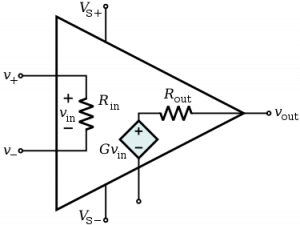Points of Discussion
- Structures, PIN outs & Schematics
- Types & Applications
- Various kinds of IC
- Important Parameters, Rules, Equations
Structures, PIN outs & Schematic
Op amp diagram
The op-amp diagram marks the inputs, outputs, and saturation voltage connections. It is an open-loop system. The below image represents an op-amp diagram.

Op amp pinout
In-general typical op-amp ICs have eight pins. Seven are functional, while one pin is dedicated for output. It takes four inputs; 2 of them are for inverting terminal and non-inverting terminal, and the rest 2 are for positive and negative saturation voltage. The pinout of IC741 is given above.
Op amp schematic
The below image gives a schematic view of an op-amp.

As we can see in the image, an op-amp consists of transistors and resistors. The input impedance is high because of the Darlington pair of the NPN transistors. There are two differential gain stages, and the output is taken from the single-ended emitter follower. The transistors T1 and T2 are identical, and so as the T3 and T4.
Types and Applications
Op amp applications | Op amp uses
Op-amps are one of the essential elements for circuit designing in electronics. They are used in various places. Some of the examples are –
Unity gain buffer, phase shift oscillator, current to voltage follower, the voltage to a current follower, summing amplifier, integrator, differentiator, half-wave rectifier, peak detector, etc. There are many more applications of the op-amp. Almost every electronic gadget is incorporated with an op-amp.
High pass filter op amp
A high pass filter can be built using an RC filter circuit and a typical op-amp. Combining a passive RC filter with op-amp functions like an active high pass filter. The inverting or non-inverting terminal operation of the op amp is required for the circuit. The below image represents a high pass filter op amp circuit.
Op amp bandpass filter
A bandpass filter allows a signal of the specified frequency range only. This filter filters out other components of frequencies. Op-amps are used to make such types of filters. The circuit is designed by cascading a high pass filter with an op-amp and then a low pass filter.
Subtractor op amp
Subtractor op-amp amplifies the difference between the two input voltages and provides that as output. It performs the subtraction operation, unlike a summing amplifier which adds up the input voltages. That is why it is known as subtractor op-amp.
Op amp adder
Op-amp adder or summing amplifier is the amplifier that amplifies the summation of the input voltages and provides as output. It performs summation or addition operation, unlike a differential amplifier which performs subtraction operations. The circuit diagram is given above.
Unity Gain op amp
A unity gain op-amp or a voltage follower circuit, or a buffer circuit is a specially designed non-inverting amplifier model. Observe the circuit of the non-inverting amplifier given above. If we made the feedback resistance zero and the inverting terminal infinite resistance, the amplifier’s gain would be unity. That is why this circuit is known as unity gain op-amp or unity gain buffer. This buffer is used for impedance matching.
Op amp oscillator
It is also possible to create an oscillator using an op-amp. The below-given image represents the circuit diagram of a phase shift RC oscillator.

After some general calculations, we have found out that oscillation frequency is f = 1/ (2πRC -/6) and the voltage gain Av = -29 for sustained oscillation.
Audio op amp
Operational amplifiers are heavily used in audio processing and audio mixers. An op-amp can amplify weak voice signals. Several types of audio op-amps are available in the market. Some of them are – LT1115, UA741, etc.
Op amp level shifter
In a single supply op-amp, the op-amp can level shift a ground-referenced signal. A level shifter can translate logic signals from one level to another. Sometimes there is a need for converting a positive to negative signal into an acceptable range for a single supply analog to digital converter.
Op amp voltage divider
Op-amps are also used as a voltage divider. Op-amp is used to make voltage dividers as using op-amp can increase the system’s gain.
Single supply op amp
Single supply op amp is such a special op-amp with only one supply terminal. The supply terminal is typically the +Vcc. So, the output lies between the range of +Vcc and the ground (GND) for an input signal.
High Voltage op amp
A high voltage amplifier is typically used to amplify the input signal to a high voltage output signal. It can provide the power gain at the voltage and current combinations. Some of the high voltage op-amps applications are – inkjet printers, ultrasound transducer, Geiger counters, biomedical tests, etc.
For Detail Circuit Analysis of Circuits… Click Here!
Various kinds of IC
45588 op amp
It is another integrated circuit that operates op-amp. It is a high-performance eight-pin IC that doesn’t need any external frequency compensator components. Some of the other models are – CF158MT, AN45588, LA6458, etc.
lm358 op amp
lm358 is another type of IC that consists of a couple of op-amps. It is a low-power IC, which National Semiconductor first developed.
ua741 op amp
This is another type of IC that includes an operational amplifier. It has eight pins. The maximum supply voltage is +18V, and the maximum differential input voltage is +15V. The CMMR is 90 dB. UA 741 is used in audio applications, music players.
Lm324 op amp
Lm324 is a specially built IC, which can function as an amplifier, comparator, rectifier, etc. This IC has 14 pins, representing four op-amps. It has a wide bandwidth of around 1 MHz and a gain of 100 dB. They are applied in various fields of robotics, oscillators, etc.
Ne5532 op amp
Another IC of the op-amp is ne5532. It is a high-performance amplifier that has excellent DC and AC voltages. It has low noise, maximum output swing bandwidth, and a high slew rate. Different variations of this type of ICs are – NE5532A, SA55332, etc.
Important Parameters, Rules, Equations
Op amp circuit analysis
The op-amp circuit analysis reveals the functionality of each part of an op-amp and how they are connected or interconnected to provide the output path. Circuit analysis of op-amp can be classified into two types –
- open-loop circuit analysis
- closed-loop circuit analysis.
The open-loop circuit analysis analyzes the system without the feedback system, and the closed-loop circuit analysis is the analysis of a circuit with a feedback system.
The concept of virtual ground, high input impedance, and infinite gain are necessary for the op-amp circuit analysis.
Op amp golden rules
One op-amp designer should always keep in mind some essential rules. They are –
- Op amp provides infinite gain.
- The input impedances are high.
- No current flows through the op-amp at the beginning.
- The offset voltage is adjusted to make it zero.
Op amp formulas
There are no hard and fast formulas for the op-amp. There are several types of op-amps, and they have their specific equations and formulas. Like – formulas for output of Non inverting op amp: V0 = [ 1 + (Rf/R1)] * Vin and formulas for output of Inverting op amp: V0 = – (Rf/R1) * Vin
Input impedance of op amp
The input impedance is high because of the Darlington pair of the NPN transistors. For an ideal op-amp, the input impedance is infinite. Due to the high input impedance, we can assume that the current flows through the feedback at the beginning stage. Typically, the values are in between 1 megaohm to 10 tera ohms.
Output impedance of an op amp
Output impedance of op-amp referrers to the impedance provided by an op-amp at the output stage. An ideal has an output impedance of 0 ohms. The output driver circuit causes the output impedance of an op-amp.
Open loop gain of op amp
Open loop gain of an op-amp is the device’s gain when there is no feedback associated with it. For an ideal op-amp, the open-loop gain is infinite. A typical open-loop gain of the typical op-amp is around 100 dB.
Op amp offset voltage
An op-amp’s offset voltage is defined as the differential DC voltage between the input terminals. For an ideal op-amp, the offset voltage is zero. But for the practical op-amp, the external voltage is given to the op-amp.
Slew rate of op amp
Slew rate of the op-amp is the rate of change of the output signal if there is a step-change in the input signal. It is a parameter for the measurement of performance. The unit of slew rate is V/ ms. For an ideal op-amp, the slew rate is zero. It means that the input change will be reflected immediately in the output. For a typical practical op-amp, the slew rate value is 10 V / μs.
Op amp bandwidth
The bandwidth of an amplifier is referred to as the range of frequency above which the gain of the amplifier is higher than 3 dB. For a 741 MHz amplifier, the closed-loop amplifier is 1 MHz.
Op amp current source
An external current source with an op-amp provides a load resistance independent current. And as we have previously grounded the circuit, there is no chance of exposing two connections.
Op amp transfer functions
It is possible to obtain transfer functions of op-amp if the op-amps are represented in a classical feedback block diagram. Using the process of superposition, the transfer function can be obtained. The transfer function for the non-inverting terminal can be written as R1 / (R1 +Rf).
Op amp saturation
There is two input terminals, which takes positive and negative saturation voltages. Now, when an op-amp is in saturation, it means that the op-amp’s output is any of the saturation voltage provided from the supply.
How does an op amp work?
An op-amp typically goes through three stages of operations. The first one – differential input stage with higher input impedance, the gain stage in the second stage, and the push-pull output stage of lower output impedance.
What does an op amp do?
An op-amp or operational amplifier is an electronics device that performs certain mathematical operations and amplifies the input signal.

Hi, I am Sudipta Roy. I have done B. Tech in Electronics. I am an electronics enthusiast and am currently devoted to the field of Electronics and Communications. I have a keen interest in exploring modern technologies such as AI & Machine Learning. My writings are devoted to providing accurate and updated data to all learners. Helping someone in gaining knowledge gives me immense pleasure.
Let’s connect through LinkedIn –